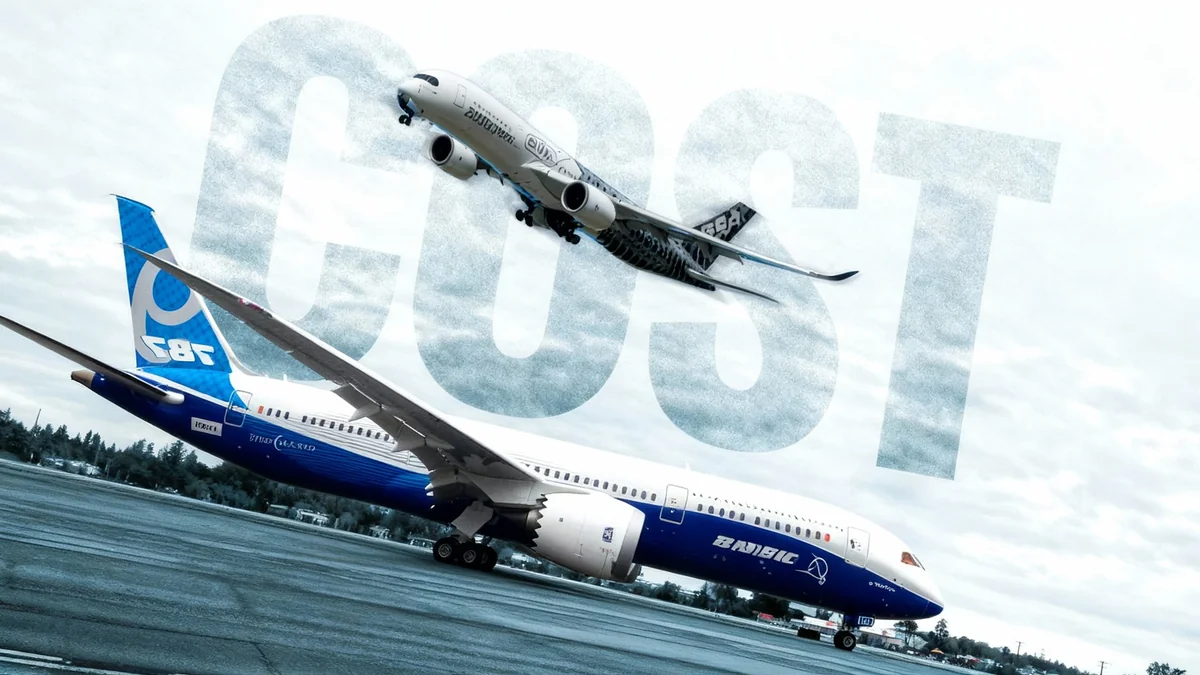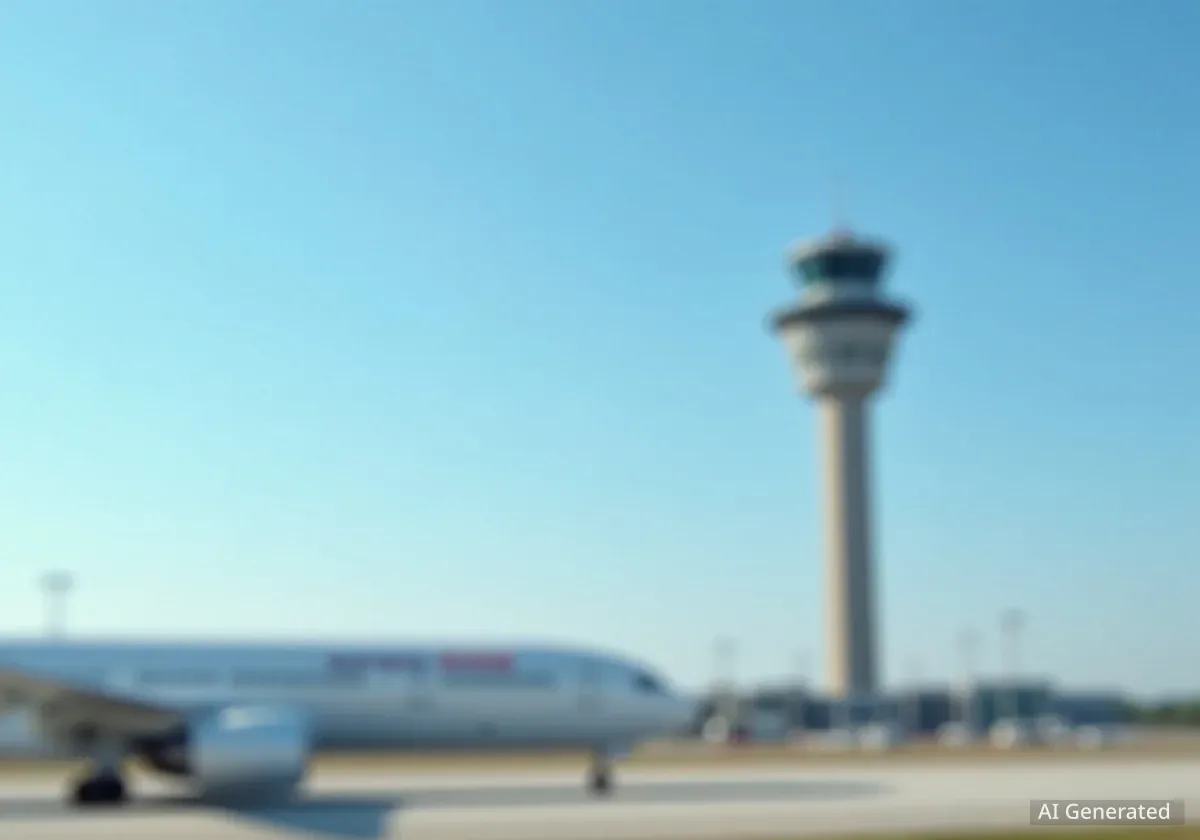Airlines face a significant decision when choosing new widebody aircraft, weighing initial purchase prices against long-term operating costs. The Boeing 787 Dreamliner and Airbus A350 are two leading contenders in this market, each offering distinct advantages. Our analysis shows that the 787 generally has a lower list price, while the A350 often boasts better fuel efficiency and lower operating costs per seat, particularly on long-haul routes.
Key Takeaways
- Boeing 787 Dreamliner variants typically have lower list prices than the Airbus A350.
- The Airbus A350 generally offers lower operating costs per seat hour due to superior fuel efficiency.
- Chartering a Boeing 787 costs around $30,950 per hour, while an Airbus ACJ350 costs $30,000-$40,000 per hour.
- Aircraft purchase and fuel are only about 20% of an airline's total operating expenses.
- Fleet commonality and efficient route utilization are critical for managing costs.
Comparing Aircraft List Prices
The price an airline pays for a new aircraft is rarely the official list price. Manufacturers often offer substantial discounts, especially for large orders. However, list prices provide a benchmark for comparison between models.
The Airbus A350 comes in two main variants. The A350-900 has a list price of $317 million. Its larger sibling, the A350-1000, is priced at $367 million.
Boeing's 787 Dreamliner family includes three variants. The smallest, the 787-8, has a list price of $248 million. The mid-sized 787-9 is listed at $292 million. The largest, the 787-10, carries a list price of $338 million.
Quick Fact
Only the Boeing 787-10 has a list price higher than the A350-900. All 787 variants are cheaper than the A350-1000 at list price.
Chartering Costs for Business and Private Use
Beyond purchasing, aircraft can also be chartered for private or business use. These hourly rates cover the aircraft's use, crew, fuel, and other services.
For a Boeing 787, the estimated average charter cost is around $30,950 per hour. This figure can increase based on the specific variant and additional luxury services like premium cabin crew or special inflight catering.
The business jet version of the A350, known as the Airbus ACJ350, has a charter cost estimated between $30,000 and $40,000 per hour. This hourly rate includes a base charter fee, operating costs (around $15,000-$20,000 per hour), fuel, crew salaries, and insurance.
Key Aircraft Specifications Comparison
To illustrate the similarities and differences, consider the 787-9 and A350-900 variants, which often compete directly:
- Maximum Seats: Both can accommodate up to 440 passengers.
- Wingspan: 787-9 at 197 ft 3 in (60.12 m) vs. A350-900 at 212 ft 5.2 in (64.75 m).
- Maximum Takeoff Weight: 787-9 at 560,000 lb (254,000 kg) vs. A350-900 at 623,908 lb (283,000 kg).
- Range: 787-9 offers 6,330 nautical miles (11,720 km), while the A350-900 has a greater range of 8,500 nautical miles (15,750 km).
- Cruising Speed: Both aircraft maintain a cruising speed of 488 knots.
Operating Costs Per Seat Hour
Operating costs are a major factor for airlines. These costs include fuel, maintenance, crew, and other expenses, often calculated per seat hour to assess efficiency.
For the Boeing 787 Dreamliner, operating costs vary by variant:
- The 787-8, the smallest, has the highest per-seat cost at $30 per seat hour.
- The popular 787-9 operates at $25.86 per seat hour.
- The largest variant, the 787-10, boasts the lowest cost per seat at $19.54 per hour.
The Airbus A350 demonstrates strong fuel efficiency, which contributes to its competitive operating costs. Airbus states the A350 has a 25% lower fuel burn compared to its closest competitors. It also offers 25% lower maintenance costs than the 777 family.
The A350's operating cost per seat is approximately $22.81 per seat hour. This figure is lower than most 787 variants, with the exception of the high-capacity 787-10.
Beyond the Aircraft: Other Airline Expenses
While aircraft purchase and fuel are substantial, they represent only about 20% of an airline's overall operating costs. Many other expenses contribute significantly to an airline's financial structure.
Unexpected costs can include airport and navigation fees, which account for about 8% of total operating costs. Total distribution costs, covering fees paid to travel agents and booking platforms, make up another 6%. Passenger services add approximately 5%.
Staff salaries and training are also major expenditures. Salaries are often set through union negotiations or experience-based pay scales, limiting an airline's ability to reduce these costs. Benefits such as pension contributions and bonuses further increase personnel expenses.
Airlines can reduce some costs through automation, such as self-check-in kiosks. Training costs, particularly for pilots, cabin crew, and ground engineers, are influenced by the diversity of an airline's fleet. A fleet focused on a single aircraft type or manufacturer can lead to greater commonality in training and maintenance, thereby reducing costs.
Strategic Cost Management at Scale
Large airlines often employ sophisticated strategies to manage operating costs, especially with extensive fleets. Singapore Airlines, for example, is the world's largest A350 operator, with over 50 aircraft in service. They utilize these jets for long-haul and ultra-long-haul routes, connecting Singapore to destinations in the USA and Europe.
Singapore Airlines focuses on maximizing the A350's financial efficiency. The aircraft performs best on high-yield, long-haul routes, leveraging its superior fuel efficiency and impressive range. Using the A350 for shorter routes would result in much higher costs per seat.
Having a large, standardized fleet of A350s also brings advantages in terms of fleet commonality. This allows Singapore Airlines to standardize pilot training and maintenance procedures. It also enables them to maintain a comprehensive spare parts inventory, reducing repair times and keeping aircraft in the sky longer. This strategic approach helps to reduce overall operating expenses while maintaining a premium service.
Some airlines also engage in fuel hedging, buying large quantities of fuel when prices are low to lock in better rates. Delta Air Lines took this strategy a step further in 2020 by acquiring a fuel refinery, as reported by the New York Times, demonstrating a highly creative approach to controlling fuel costs.





